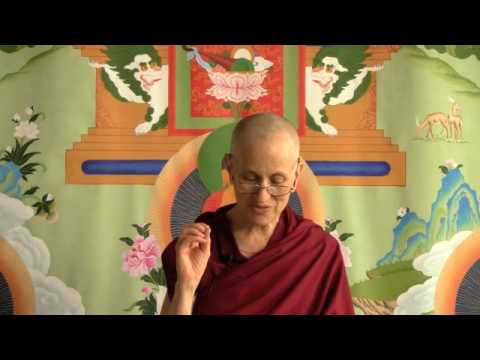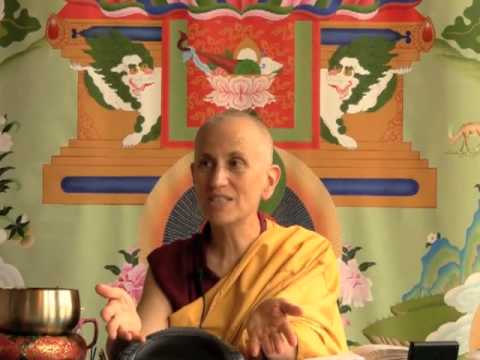Absorption factors and the jhanas
Stages of the Path #132: The Fourth Noble Truth
Part of a series of Bodhisattva’s Breakfast Corner talks on the Stages of the Path (or Lamrim) as described in the Guru Puja text by Panchen Lama I Lobsang Chokyi Gyaltsen.
- Entering the first jhana
- Progressing through the jhanas
Part 1:
Part 2:
To keep talking about the five absorption factors, as I was saying before, you repress the five hindrances (or they are repressed with access concentration) but the absorption factors aren’t fully developed at that time. When the absorption factors are fully developed and the hindrances are repressed that’s when you enter into the first jhana. Then to succeed in going through the different jhana stages you contemplate the faults of the lower stage of concentration and the benefits of the higher stage. In that way what you do is you let go of certain of these absorption factors, actually, some of them are released, and through that the mind gets subtler and you are able to progress from the first to the second stage of concentration, to the third, to the fourth. It’s done by this process which is also a form of insight, actually, it’s a worldly form of vipassana, of meditating on the faults of the lower stage of concentration and the benefits of the higher ones.
In the first concentration you have all five of the jhana factors: coarse engagement, subtle engagement, rapture, bliss, and one-pointedness. What’s absent there is all of the five hindrances.
When you go from the first jhana to the second you let go of the coarse engagement and the refined engagement, because those are rougher minds and they aren’t needed anymore. So as the concentration becomes deeper, those two mental factors kind of subside, and then you have the rapture, bliss, and one-pointedness. In that stage you also have a greater sense of internal stillness, much more one-pointedness of the mind, deeper bliss from the concentration.
When you go from the second to the third you let go of the rapture, because the rapture, although feeling very good, there’s an agitated quality, it’s a bit like being on a high, like giddy, so they say, I don’t have any experience. So that in itself becomes a little bit of a distraction to deepening the meditation. So going from the second to the third, then the rapture is released and you’re left with the bliss and the single-pointedness. And so at that point you begin to have much more equanimity. Of course you still have your mindfulness and your introspective awareness.
Also the body’s quite blissful, that started happening with the generation of serenity with access concentration.
Then going from the third to the fourth concentration you release the bliss, because the bliss is, again, it’s elevating the mind so somehow it distracts from the stillness. So the bliss is released, you’re left with one-pointedness, and at that point then you have a feeling of equanimity. We would usually say, “Wow, I’d rather have bliss than equanimity.” Wouldn’t we? But in the deep states of concentration then even the bliss can be somehow over-the-top or somehow preventing the depth of the concentration. So when that’s released, then the equanimity becomes very, very stable, so the meditation becomes very deep. And so at that point the mindfulness attains a much stronger state of purity, and it’s said that the mind is purified, bright, unblemished, free of imperfection, malleable, wieldly, steady, and attained to imperturbability.
Those are the four states of jhana.
Then if you’re going to do the formless absorptions, then you change a little bit because the first formless absorption is infinite space. So there you imagine whatever your object of meditation was filling all of space, and then you remove your object and just stay focused on the space.
Then going to the second formless is infinite consciousness, then you see that there’s a consciousness that’s perceiving the space, so the consciousness is infinite like the space and you dwell on that.
When you get to the third that’s the base of nothingness, then you eliminate the consciousness and you stay focused on nothingness.
The fourth is called the peak of samsara, or “neither discrimination nor non-discrimination,” and at that point the mind’s very refined that it’s very difficult to say whether you can even discriminate objects or can’t.
But those four formless ones, though deeper states of concentration, are not very good for meditating on wisdom because the mind is too refined, too much like that.
[In response to audience] Can you go into the formless absorptions with the idea that you’re meditating on emptiness?
If you’ve been able to focus on actual emptiness, the non-affirming negative, while you’re still in the jhanas, then I don’t think you lose that going into the formless. But I don’t think you’re going to meditate on emptiness so much in the formless absorptions because they’re just too, the mind’s too refined, they say it’s not as beneficial.
[In response to audience] Well it’s beneficial in the sense…. I mean, the bodhisattvas perfect all those stages of concentration, and they’re able to go in and out of all these different stages in one moment, so it makes the mind very nimble, and very quick, which of course if you’re a bodhisattva is going to be really important if you want to emanate many bodies to be of benefit to sentient beings. So developing that kind of dexterity with your mind, I think the bodhisattvas would use those kinds of concentrations for that purpose.
[In response to audience] When you have, in the first jhana you have the coarse and refined engagement. They’re really important to keep your mind on the object. But once you go to the second jhana you don’t need those so much.
[In response to audience] It could be a virtuous object, it could be a neutral object. The Buddha also taught this meditation on the kasinas.
Audience: They often say that the supernatural powers are gained through concentration. That’s a pretty broad statement considering there are eight levels of absorption.
Venerable Thubten Chodron: They say usually that the supernatural powers, you work with the fourth jhana, if I remember correctly, to gain those.
Different miraculous powers—going under the earth and walking on water and that kind of stuff. And then the divine eye that can see other places. The divine ear which can hear sound, different sounds. The ability to see previous lives, one’s own previous lives. And the ability to see sentient beings dying and being reborn again. And sometimes they include the sixth one, which is knowledge of the destruction of all taints, of all pollutants in other words, knowledge that you’ve attained liberation.
So it gives us some idea that these kinds of states of concentration are possible. And they say we’ve even had them before and been born in those realms before. But since we haven’t had renunciation, we haven’t had wisdom, though we’ve gotten born in those realms, then after that karma is used up, then back down to the desire realm.
Venerable Thubten Chodron
Venerable Chodron emphasizes the practical application of Buddha’s teachings in our daily lives and is especially skilled at explaining them in ways easily understood and practiced by Westerners. She is well known for her warm, humorous, and lucid teachings. She was ordained as a Buddhist nun in 1977 by Kyabje Ling Rinpoche in Dharamsala, India, and in 1986 she received bhikshuni (full) ordination in Taiwan. Read her full bio.


